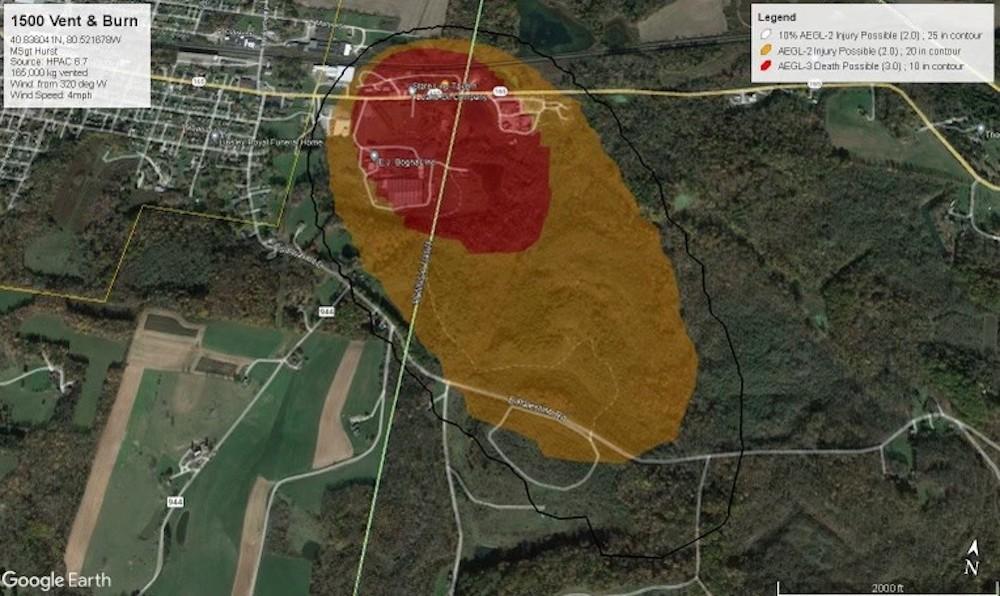Toxic Chemical Fallout: The Long-Term Impact Of The Ohio Train Derailment

Table of Contents
Environmental Contamination: A Lingering Threat
The Ohio train derailment resulted in significant soil and water pollution. The release of vinyl chloride and other hazardous substances poses a long-term threat to the local ecosystem.
Soil and Water Pollution: A Persistent Problem
The extent of soil and groundwater contamination from the spilled chemicals remains a major concern. Vinyl chloride, a known carcinogen, is particularly persistent in the environment, potentially leaching into groundwater sources for years to come.
- Contamination Levels: Initial reports indicated high levels of vinyl chloride and other contaminants in the soil and water near the derailment site. Further testing is needed to fully assess the extent of the contamination.
- Long-term Effects on Ecosystems: The contamination poses a significant threat to local wildlife and plant life. Bioaccumulation of toxins in the food chain could have devastating consequences for the entire ecosystem.
- Remediation Challenges: Cleaning up the contamination will be a complex, costly, and lengthy process. The long-term effectiveness of remediation efforts remains uncertain. The sheer scale of the soil contamination and the unpredictable nature of groundwater flow present significant challenges for environmental cleanup.
Air Quality Impacts: Breathing the Consequences
The burning of vinyl chloride to prevent a larger explosion released toxic air emissions that impacted air quality in the surrounding area. This had short-term and long-term health consequences for residents.
- Specific Pollutants: Besides vinyl chloride, other harmful pollutants were released into the air, including hydrogen chloride and phosgene.
- Long-term Health Concerns: Exposure to these pollutants can lead to respiratory problems, such as asthma and bronchitis, and potentially more severe long-term health issues.
- Air Quality Monitoring: While immediate air quality monitoring was conducted, continuous long-term monitoring is crucial to assess the lasting effects on air quality and public health. Data comparisons between pre- and post-derailment air quality are essential for a complete understanding of the impact.
Long-Term Ecological Consequences: An Uncertain Future
The long-term ecological consequences of the Ohio train derailment are still unfolding, but the potential for irreversible environmental damage is substantial.
- Bioaccumulation: The bioaccumulation of toxins in the food chain poses a severe risk to wildlife populations and can have cascading effects throughout the ecosystem.
- Biodiversity Loss: The contamination could lead to significant biodiversity loss, impacting various plant and animal species that inhabit the affected area.
- Irreversible Damage: The extent of irreversible environmental damage will depend on the effectiveness of remediation efforts and the resilience of the affected ecosystem. The possibility of long-term ecosystem disruption necessitates comprehensive ecological monitoring.
Human Health Impacts: A Growing Concern
The Ohio train derailment has already resulted in immediate health problems for residents and raises significant concerns about long-term health effects.
Immediate Health Effects: A Wake-Up Call
Following the derailment, residents reported a range of immediate health effects consistent with exposure to toxic chemicals.
- Symptoms: Symptoms included headaches, nausea, respiratory problems, skin irritation, and eye irritation.
- Medical Response: Local hospitals and medical facilities reported an increase in emergency room visits and hospitalizations in the immediate aftermath of the derailment.
- Statistics: Precise statistics on the number of individuals affected and the severity of their symptoms need further investigation and data collection.
Long-Term Health Concerns: A Looming Shadow
The long-term health consequences of exposure to the released chemicals are a significant and growing concern.
- Cancer Risk: Vinyl chloride is a known human carcinogen, increasing the risk of various cancers, including liver cancer and brain cancer. Longitudinal studies are needed to properly assess the increased cancer risk in the affected population.
- Chronic Illnesses: Exposure to these toxins could lead to a range of chronic illnesses, including respiratory diseases, cardiovascular problems, and neurological disorders. Long-term health monitoring is vital for tracking these chronic health issues.
- Ongoing Monitoring: Long-term health monitoring of the affected population is essential to understand the full extent of the long-term health consequences. Comprehensive health surveillance programs must be implemented.
Psychological Impacts: The Invisible Wound
Beyond physical health, the derailment has had a significant psychological impact on residents.
- Mental Health: The stress, anxiety, and fear associated with the event have caused widespread mental health problems in the community.
- Community Trauma: The event has created collective trauma for the community, affecting residents' sense of safety and well-being.
- Mental Health Support: Increased access to mental health services and support is crucial for addressing the psychological impacts of this environmental disaster.
Economic and Social Repercussions: A Devastating Blow
The Ohio train derailment has had profound economic and social repercussions for the affected community.
Economic Losses: A Crushing Burden
The derailment has caused significant economic losses to the local community, including:
- Business Closures: Businesses have been forced to close due to the contamination and disruption caused by the derailment.
- Property Devaluation: Property values have plummeted in the affected area, impacting homeowners and investors.
- Agricultural Losses: The contamination could significantly impact agricultural production, potentially leading to crop failures and livestock losses. The extent of agricultural damage requires further investigation.
Social Disruption: Fractured Community
The derailment has also caused significant social disruption, including:
- Community Displacement: Residents were forced to evacuate their homes, creating displacement and disrupting their lives.
- Trust Issues: The response to the derailment has eroded public trust in government agencies and responsible parties. Rebuilding trust is essential for the recovery of the community.
Government Response and Accountability: A Critical Examination
The government's response to the Ohio train derailment has been subject to scrutiny, with questions raised about the speed and effectiveness of the initial response and the long-term actions taken.
Initial Response: A Mixed Bag
The initial response to the derailment was criticized for its speed and effectiveness, raising concerns about regulatory failures and the preparedness of emergency response systems. The speed of response and the initial information provided have been a major focus of concern for residents and experts alike.
Long-Term Actions: A Path to Recovery?
The long-term actions taken by the government will determine the extent of environmental remediation and the support provided to affected communities. Ongoing cleanup efforts, along with provisions for long-term health monitoring and support are crucial for recovery. Government transparency and commitment to addressing the long-term effects will be pivotal.
Legal Ramifications: Seeking Justice
Several legal actions have been filed against Norfolk Southern and other responsible parties, seeking accountability for the damages caused by the derailment. The pursuit of legal remedies will be an important step in holding responsible parties accountable and ensuring compensation for affected communities.
Conclusion: Understanding the Lasting Legacy of the Ohio Train Derailment
The Ohio train derailment serves as a stark reminder of the potential long-term consequences of toxic chemical spills. The lasting environmental, health, economic, and social impacts of this disaster demand immediate action and sustained commitment. Ongoing monitoring, comprehensive remediation efforts, and stricter regulations are crucial to mitigate the effects and prevent future tragedies. We must demand accountability from responsible parties and support efforts to ensure the health and safety of affected communities. Contact your elected officials and advocate for stronger environmental regulations and improved safety standards for the transportation of hazardous materials. The long-term health effects of the Ohio train derailment, a significant example of a toxic chemical spill, necessitate continued vigilance and proactive measures to prevent future incidents. Let's learn from this catastrophe and work towards a safer future by advocating for improved safety measures and stringent regulations in the transportation of hazardous materials.

Featured Posts
-
 Pari Sen Zermen Synexizei Stin Euroleague Gia Tin Epomeni Sezon
May 01, 2025
Pari Sen Zermen Synexizei Stin Euroleague Gia Tin Epomeni Sezon
May 01, 2025 -
 Thang Lon Tam Hop Vuot Mat 6 Doi Thu Trung Thau Du An Cap Nuoc Gia Dinh
May 01, 2025
Thang Lon Tam Hop Vuot Mat 6 Doi Thu Trung Thau Du An Cap Nuoc Gia Dinh
May 01, 2025 -
 Where To Stream Michael Sheen And Sharon Horgans Compelling British Drama
May 01, 2025
Where To Stream Michael Sheen And Sharon Horgans Compelling British Drama
May 01, 2025 -
 Popular American Cruise Lines Reviews And Comparisons
May 01, 2025
Popular American Cruise Lines Reviews And Comparisons
May 01, 2025 -
 Tanner Bibees First Pitch Homer Guardians Overcome Judge And Yankees 3 2
May 01, 2025
Tanner Bibees First Pitch Homer Guardians Overcome Judge And Yankees 3 2
May 01, 2025
Latest Posts
-
 Lars Klingbeil Receives Order For Commitment To Animal Welfare
May 01, 2025
Lars Klingbeil Receives Order For Commitment To Animal Welfare
May 01, 2025 -
 Kamala Harris A New Chapter In American Politics
May 01, 2025
Kamala Harris A New Chapter In American Politics
May 01, 2025 -
 Analysis Kamala Harris Unsuccessful Attempt To Inspire Louis Armstrong Musical Cast
May 01, 2025
Analysis Kamala Harris Unsuccessful Attempt To Inspire Louis Armstrong Musical Cast
May 01, 2025 -
 From Hamas Hostage To Global Icon Noa Argamanis Time 100 Recognition
May 01, 2025
From Hamas Hostage To Global Icon Noa Argamanis Time 100 Recognition
May 01, 2025 -
 Is A Kamala Harris Political Re Entry Imminent
May 01, 2025
Is A Kamala Harris Political Re Entry Imminent
May 01, 2025
